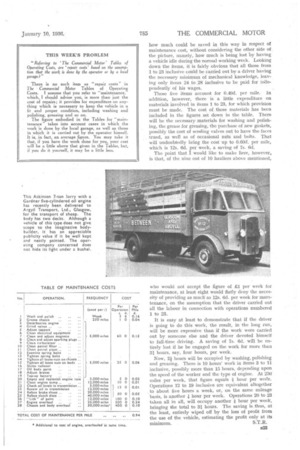Does Maintenance by Drivers Pay?
Page 40

Page 41

If you've noticed an error in this article please click here to report it so we can fix it.
(Left) The operator of this Fordson 2-ton forward-control furniture van, with a Lawson body of over 1,000 cubic ft. capacity, appreciates its value as a publicity medium. The vehicle was supplied by Wallace, Carr and Co., Ltd., London, S.W.
Minimum _Cost Figures that will Surprise Many Small Hauliers. How to Assess Maintenance Charges
THE accompanying table summarizes the information set out at length in the previous article. It -demonstrates that the cost of maintenance per mile for a 2-ton van covering about 250 miles per week is 0.94d. per mile, which is equivalent, for all practical purposes, to .21 per week.
Now, I know from personal experience that nine hauliers out of 10 operating this type and size of vehicle will flatly deny that maintenance costs them anything like 21 per week. ' I invite those nine hauliers to run down the items in the table, to consider the periods at which I suggest the various operations should be carried out, to assess the cost for doing the work and, if they have any criticism, to write to me, because I would like to have such comment.
One apparent means for economizing, of course, is to carry out the operations less frequently. That, however, is definitely a " penny wise, pound foolish" policy. The most practical way of circumventing the difficulty to *which I have recently referred occasionally, namely, that it is impossible accurately to forecast the cost of maintenance, is to determine, so soon as the vehicle is put into commission, that maintenance will be effected on certain well-organized lines, approximating closely to those laid down in the previous article and exemplified in the accompanying table. To proceed in this way corresponds closely to what, in very large organizations, is called budgetary control.
The railway companies are fond of that method of dealing with expenditure in, for example, their road-transport departments. At the beginning of. the year the road-transport manager is asked to prepare an estimate of the amounts which he expects to spend on new vehicles, on maintenance, on tyres and so on through out the whole schedule of items of expenditure. A haulier with any number of vehicles, right down to one, could, with advantage, adopt a similar scheme. In doing so, he .would have to prepare, in the case of a 2-ton van operating about 250 miles per week, to set aside 21 per week for maintenance.
It has been suggested to me, in some quarters, that the cost. per mile for maintenance is seriously affected by the annual mileage, inasmuch as some maintenance operations are not required any more frequently even if the weekly mileage increases. If the accompanying table be considered in this light, there does not appear to be much ground for that suggestion. The only item affected is the first one, "wash and polish."
It is quite likely that even if the weekly mileage were doubled, it would still be thought unnecessary to wash the vehicle more than once per week. If the mileage were doubled, the incidence of that item per mile would be halved. In other words, it would be reduced from 0.16d. per mile to 0.08(1. per mile, effecting a reduction of the total by a corresponding amount and reducing that from 0.94d. per mile to 6/.86d. per mile.
The only circumstances which would contribute towards a reduction in maintenance costs would be those in which it was possible to arrange the work so that the driver himself could carry out these essential operations within the ordinary 48 hours per week, which period is all that is covered by the normal wages paid. The objection to that method is that it reduces the hours of the day during which the vehicle is at work and earning a profit for the operator. Later I will discuss this point in its economic aspect.
Meantime, it is of interest to endeavour to estimate how much could be saved in this way in respect of maintenance cost, without considering the other side of the picture, namely, how much is being lost by having a vehicle idle during the normal working week. Looking down the items, it is fairly obvious that all those from 1 to 23 inclusive Mild be carried out by a driver having the necessary minimum of mechanical knowledge, leaving only items 24 to 28 inclusive to be paid for independently of his wages.
Those five items account for 0.49d, per mile. In addition, however, there is a little expenditure on materials involved in items 1 to 23, for which provision must be made. The cost of those materials has been included in the figures set down in the table. There will be the necessary materials for washing and polishing, the grease for greasing, the purchase of new gaskets, possibly the cost of sending valves out to have the faces trued, as well as of occasional nuts and bolts. That will undoubtedly bring the cost up to 0.60d. per mile, which is 12s. 6d. per week, a saving of is. 6d.
The point that I would like to make here, however, is that, of the nine out of 10 hauliers above mentioned,




































































































